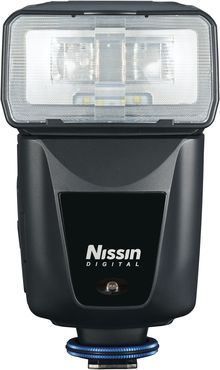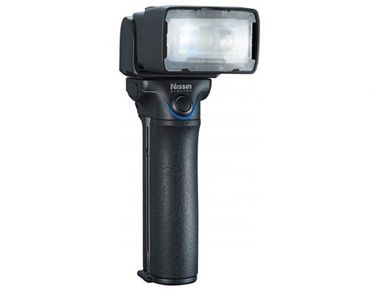Nissin flash units: reasonable price despite high quality
When natural light is not enough to expose a photo correctly, photographers have no choice but to resort to flash. Almost every modern camera model has an internal flash, but most photographers are extremely reluctant to use it. This is not surprising, because the direct flashing of the subject often considerably impairs the effect of the picture. For example, unattractive red eyes occur when people or animals are photographed. But harsh shadows and a strong light fall-off can also reduce the overall impression of the picture.
The alternative to using the flash would be to increase the ISO value or to expose longer. The former, however, results in unsightly image noise, which is also perceived as annoying. The latter, on the other hand, can cause blurring and blur in the image. One thing is certain: sometimes photographers cannot avoid using the flash. It provides an enormous amount of light in a very small space and is not dependent on the power supply. Accordingly, the flash can also be used where, for example, a studio light would not be usable due to a lack of power supply. Instead of using the internal camera flash, however, you should use an external flash in this case. It is not only characterised by a better guide number, but also offers the possibility through various settings to create a soft, natural light despite the flash and to avoid red eyes. By playing with different flash modes of the external flash unit, you can create unique effects that turn every picture into a unique work of art.
But which flash unit is right for you? There is no blanket answer to this question, because the range of external flashes is extremely wide and versatile. For owners of a system or SLR camera, in addition to flash units from renowned camera manufacturers such as Canon or Nikon, there are also Nissin flashes that are suitable for all common camera models. They are characterised by high quality, but are still comparatively inexpensive. You will find a large selection of Nissin flashes in our shop. Scroll down to find out more about the models of the Japanese manufacturer!
About the Nissin company and its range of flash units
Nissin is a Japanese manufacturer, which has its headquarters in Hong Kong and was founded back in 1959. The company specialises in manufacturing electronic flash units. It offers flash units for all well-known camera models such as Canon, Nikon, Sony, Fujifilm, Olympus and Panasonic. The flash units of the manufacturer do not only collect many plus points due to their high quality, but also due to their favourable price. The Nissin flash units are distributed in Germany by the Hapa team. The range also includes battery magazines for the flash units as well as other accessories such as connection cables, adapter rings and rechargeable batteries.
Nissin flash units can be divided into several classes. From the simple model to the complex professional device, everything is included. The individual models differ in particular with regard to the angle of movement of the flash head. For example, there are many units that can be moved upwards by up to 90 degrees. But the focal length of the flashes also differs enormously in some cases. Basically, the range of Nissin flash units can be divided into four different series:
- Series Di
- Series i
- MF
- MG
The individual series are distinguished from each other by their features and the areas of application for which they are suitable. Many models are considered for professional use in the studio. They are designed for SLR cameras and are equipped with wireless flash trigger functions. In addition, some have a colour LCD. These are usually powered by battery packs.
The Nissin clip-on flashes and their special features
So the Nissin flash units are suitable for quite different needs. A classic in the range is the Di466, which is available in both black and white. The system flash can be assigned to the entry-level range and is correspondingly inexpensive. With a guide number of 33, a pull-out and fold-down diffuser and a vertically swivelling zoom reflector, it nevertheless offers all kinds of practical features. It has both TTL and manual control and can also be used as a servo flash unit. However, you have to do without a display for status control with this model. In addition, the power consumption is comparatively high. If you have higher requirements, you might be well advised to go for the Di866 Mark II. It offers a guide number of 60, so it is also well suited for professional photographers. Its highlights include a silent zoom, overheating protection, a metal hot shoe and a buzzer function.
Ring flashes are also part of the Nissin product portfolio
Photographers who specialise in macro or portrait photography are sure to find suitable devices in the Nissin flash range. There are, in fact, various ring flashes that provide valuable services in portrait and macro photography. They are characterised by long mounting cables and adjustable rings, which is why they can be used on any size of lens. The MF 18 Macro ring flash is specially designed for macro photography. It comprises a two-part flash system: the control unit is connected to the camera's hot shoe, while the ring flash is mounted around the flash with an adapter. This prevents the lens from overshadowing the flash, which could cause shadows on the subject. Instead, the subject is illuminated completely evenly. The ring flash provides a guide number of 16 through several LED modelling lights. These can also be used as a continuous light.
Advantages and disadvantages of Nissin flash units
Before you decide whether or not to buy a Nissin flash unit, it is best to take a look at the following list, as it contains all the important advantages and disadvantages of these flash units and thus helps you to make a purchase decision.
The advantages:
High quality
Compatible with all cameras from popular manufacturers
Many practical features such as automatic switch-off or sleep mode
Comprehensive selection
The cons:
Compatibility not as perfect as when using the camera's own flash units
In summary, we can state that the manufacturer's range offers a wide selection of flash units. From the simple, compact flash to the high-quality and functional professional model, everything is available so that amateur photographers get their money's worth just as much as professionals. Above all, the favourable price should be emphasised. So you can't make a mistake with a Nissin flash unit, provided you don't attach importance to necessarily using an original Canon or Nikon flash on your Canon or Nikon camera.


Simply subscribe and benefit as a newsletter recipient every week: